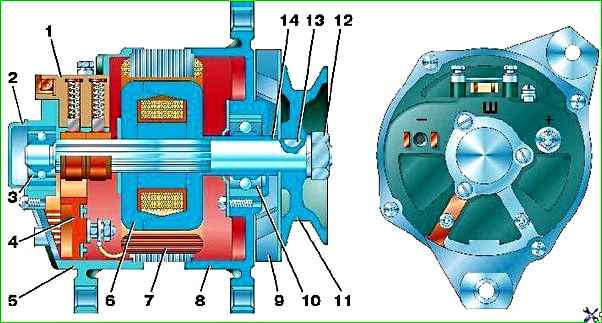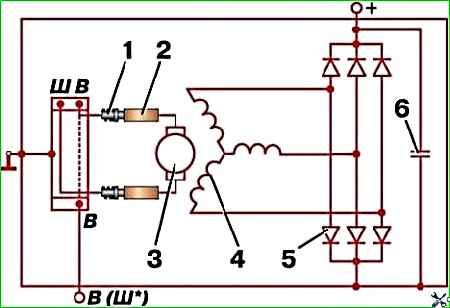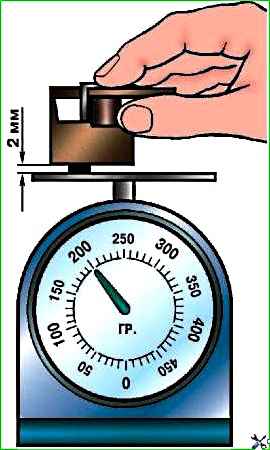G250P2 generator and generators 665.3701–01 and 161.3771:

Fig. 1. Generator G250P2

– G250P2 (Fig. 1) – alternating current with a built-in rectifier unit VBG-1 (or PBB-4-45), working in conjunction with a voltage regulator.
The electrical circuit of the generator is shown in Fig. 2.

– 665.3701–01 or 161.3771 – AC with built-in integrated voltage regulators.
The electrical circuit of the generators is shown in Fig. 3.
The generator is mounted on a bracket to the engine block on the right side.
The generator is driven by a V-belt from the crankshaft pulley.
Technical data of the generator G250P2
Rotation direction (drive side) right
Voltage (nominal), 14 volts
Rated current, 28 amperes
Maximum current, 40±5 A
Generator shaft rotation frequency at which a terminal voltage of 12.5 V is achieved at an ambient and generator temperature of 20°C, min -1:
- at current equal to zero 900
- at load current 28 A = 2100
Number of stator phases (star connected) 3
Number of coils in phase 6
Number of stator coils 18
The number of turns in the stator coil is 13
Stator winding - wire PEV-2, F 1.35–1.46 mm
Excitation coil - PEV wire, F 0.74–0.83 mm
The number of turns in the coil is 490±10
Excitation winding resistance at 20 °C, 3.7±0.2 Ohm
Excitation winding current, A, no more than 3.05±0.2
Brush type - M1
The force of pressing the springs on the brushes, gf - 180–260
Ball bearings:
- in the front cover 180603-KS9
- in the back cover 180502-KS9SH
Number of rectifier block diodes - 6
Allowable current for each diode, 10 A
Permissible voltage drop at a current of 10 A, V, no more than 1
Technical data of generators 665.3701–01, 161.3771
Rotation direction (drive side) - right
Voltage (nominal), 14 V
Maximum current, A, not less than 55 (57)
Adjustable voltage at an ambient temperature of 25±10°C, a rotor speed of 3500 min -1 and a load current of 20A when operating with the battery on, V:
- - for version “U-HL” 13.9–14.6
- - for version T 13.4–14.1
Adjustable voltage at ambient temperature from –25°C to +70°C when changing current from 5A to 40A and rotor speed from 3000 min -1 to 8000 min -1 , В:
- - for version “U-HL” 13.6–14.8
- - for version T 12.9–14.8
Start inspecting the generator with the brushes, brush holder and slip rings.
Make sure that the brushes are intact, do not jam in the brush holders and are in reliable contact with the slip rings; check the tension of the brush springs.
Brushes worn to a height of 8 mm (for generator brushes 665.3701–01 – 5 mm), replace.

Measure the force of pressing the brushes (Fig. 4) to the slip rings with a dynamometer.
To measure the force, remove the brush holder, remove one brush, install the cover on the brush holder, holding it with your hand.
Then press the end of the brush protruding from the brush holder onto the dial scale cup.
When the brush protrudes 2 mm from the brush holder, measure the scale.
The force of pressing the springs on the brushes should be 180–260 gs.
Blow out the generator with air.
Wipe the brush holder, brushes and slightly dirty contact rings with a clean cloth lightly moistened with gasoline.
Clean very dirty slip rings with slight burns and small roughness (by removing the brush holder) with 80 or 100 grit glass paper, turning the rotor by hand.
Do not use sandpaper for this.
Turn worn, burnt or excessively runout generator slip rings on a lathe and clean thoroughly.
Periodically remove the generator from the vehicle to disassemble and clean it from dirt and dust.
Inspect all parts carefully.
Check the pressing force of the brushes. Brushes should not jam in the brush holders.
Replace worn bearings.
Warnings
1. The “minus” of the battery should always be connected to ground, and the “plus” should always be connected to the “plus” terminal of the generator.
Incorrectly turning the battery back on will immediately cause increased current through the generator diodes and they will fail.
2. It is not allowed to operate the generator with the consumer wires disconnected from the “plus” terminal (especially with the battery disconnected).
This causes a dangerous increase in voltage, which leads to damage to the diodes and voltage regulator.
3. You should not check the functionality of the generator for a spark, even by briefly connecting the plus terminal of the generator to ground.
In this case, a significant current passes through the diodes and they are damaged.
You can only check the generator using an ammeter and voltmeter.





